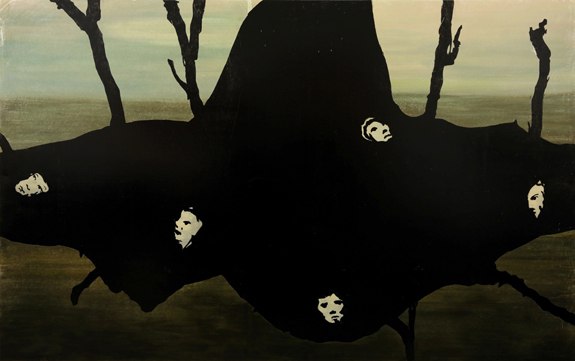ANTTI TANTTUWoodcuts and aquarelles 23.11.2013 – 22.12.2013
 The final hiding places, 2013
The final hiding places, 2013woodcut and mixed media on mdf-board
130 x 207 cm
The Human Voice
It has been said of Antti Tanttu that he creates his art in a
post-God reality, in which man must make himself into the Übermensch to
replace God. The idea derives from Friedrich Nietzsche, rather unjustly
dubbed as the God killer. But Nietzsche does not rejoice at the death
of God, on the contrary, the very notion terrifies him:
"Whither is God?" he cried; "I will tell you. We have killed him — you and I. All of us are his murderers. But how did we do this? How could we drink up the sea? Who gave us the sponge to wipe away the entire horizon?" (Friedrich Nietzsche: The Gay Science, 1882, trans. Walter Kaufmann).
It is true that even at its most mischievous, Antti Tanttu´s art is imbued with a cosmic loneliness reminiscent of Nietzsche, but it seems to me that his art actually stems from a time before the birth of God, not after His death. Tanttu´s earthly pilgrimage is not the wanderings of a soul banished from paradise. He is crossing a desert but never stops to glance over his shoulder hoping for a sight of paradise lost. If paradise does exist, it is ahead of him, not behind.
In Tanttu we have a journeyman of such passion that the eternal peace of paradise would hardly be to his taste, even if such a paradise did exist and he found his way there. Paradise, for him, would be a mere oasis, a momentary rest.
A wheelchair, the symbol of injury, often features in Antti Tanttu´s works. French author Jean Genet´s definition of art is one that, I believe, Tanttu would approve of: "There is no other source of beauty than the wound, singular, different for each person, hidden or visible, which each man keeps within himself, which he preserves and where he withdraws when he wants to leave the world for a passing but profound solitude." (Jean Genet: The Studio of Alberto Giacometti, 1957, trans. R. Howard).
Alongside the wheelchair, the theme of flight, the symbol of a yearning for freedom, is strongly present in Tanttu´s work. But the wound is ever-present: the figure in flight has just one wing and, unlike Icarus, he is not flying towards the sun, never mind too close to it. He is flying through the night; the moon will not scorch his one lone wing.
"I can´t commission my own works. If you force it, it shows." These words, expressed during my latest conversation with Antti Tanttu, are imbedded deep in the recesses of my memory. The artist labours in solitude, accompanied only by the paradox that art cannot be created, it is born. When the tectonic plates of the subconscious collide and shift, shockwaves are sent through the surface.
The titles of Tanttu´s works are a fundamental part of the message he wishes to convey to his audience. I cannot recall more than one or two unnamed works from a career spanning a quarter of a century. Of the relationship between his works and their titles, Tanttu has said the following: "I will not name anything in advance. First I create the piece, and then the name follows. The process for the emergence of both is equally unknown to me."
The face of the human figure in Voice of Man is superimposed onto a set of stylised musical staves. The viewer must decide whether the figure is listening to the human voice or is the source of that voice. The figure has both a mouth and ears. Perhaps the best interpretation is to conclude that he is both creating the voice and listening to it. Thus, the viewer is invited to participate in the dialogue and an Adornoesque miracle takes place, the very essence of all art is realised: the viewer sees the artwork, and the artwork sees the viewer. The two meet like Martin Buber´s I and Thou.
Torsti Lehtinen MA, author, philosopher
